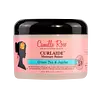What's inside
What's inside
 Key Ingredients
Key Ingredients

 Benefits
Benefits

 Concerns
Concerns

 Ingredients Side-by-side
Ingredients Side-by-side

Water
Skin ConditioningGlycerin
HumectantButyrospermum Parkii Butter
Skin ConditioningCetearyl Alcohol
EmollientCocos Nucifera Oil
MaskingAmodimethicone
Brassicamidopropyl Dimethylamine
Skin ConditioningOlea Europaea Fruit Oil
MaskingHydrolyzed Theobroma Cacao Seed Meal
Skin ConditioningPrunus Amygdalus Dulcis Oil
Skin ConditioningTriticum Vulgare Germ Oil
EmollientPEG-40 Hydrogenated Castor Oil
EmulsifyingCeteareth-20
CleansingAloe Barbadensis Leaf Juice
Skin ConditioningHydrolyzed Soy Protein
HumectantPanthenol
Skin ConditioningAspartic Acid
MaskingParfum
MaskingCyclopentasiloxane
EmollientIodopropynyl Butylcarbamate
PreservativeDMDM Hydantoin
PreservativeBenzophenone-3
UV AbsorberTocopheryl Acetate
AntioxidantTetrasodium EDTA
Simethicone
EmollientBHT
AntioxidantWater, Glycerin, Butyrospermum Parkii Butter, Cetearyl Alcohol, Cocos Nucifera Oil, Amodimethicone, Brassicamidopropyl Dimethylamine, Olea Europaea Fruit Oil, Hydrolyzed Theobroma Cacao Seed Meal, Prunus Amygdalus Dulcis Oil, Triticum Vulgare Germ Oil, PEG-40 Hydrogenated Castor Oil, Ceteareth-20, Aloe Barbadensis Leaf Juice, Hydrolyzed Soy Protein, Panthenol, Aspartic Acid, Parfum, Cyclopentasiloxane, Iodopropynyl Butylcarbamate, DMDM Hydantoin, Benzophenone-3, Tocopheryl Acetate, Tetrasodium EDTA, Simethicone, BHT
Water
Skin ConditioningOryza Sativa
Behentrimonium Methosulfate
Cocos Nucifera Oil
MaskingButyrospermum Parkii Oil
EmollientOlea Europaea Fruit Oil
MaskingCamellia Sinensis Leaf Extract
AntimicrobialSesamum Indicum Seed Oil
EmollientGlycine Soja Oil
EmollientAloe Barbadensis Leaf
MaskingRicinus Communis Seed Oil
MaskingOryza Sativa Bran Oil
EmollientMacadamia Ternifolia Seed Oil
EmollientPersea Gratissima Oil
Skin ConditioningAloe Barbadensis Leaf Juice
Skin ConditioningStearoxytrimethylsilane
EmollientSorbitol
HumectantSimmondsia Chinensis Seed Oil
EmollientAscorbic Acid
AntioxidantTocopherol
AntioxidantCaprylyl Glycol
EmollientScentenal
PerfumingWater, Oryza Sativa, Behentrimonium Methosulfate, Cocos Nucifera Oil, Butyrospermum Parkii Oil, Olea Europaea Fruit Oil, Camellia Sinensis Leaf Extract, Sesamum Indicum Seed Oil, Glycine Soja Oil, Aloe Barbadensis Leaf, Ricinus Communis Seed Oil, Oryza Sativa Bran Oil, Macadamia Ternifolia Seed Oil, Persea Gratissima Oil, Aloe Barbadensis Leaf Juice, Stearoxytrimethylsilane, Sorbitol, Simmondsia Chinensis Seed Oil, Ascorbic Acid, Tocopherol, Caprylyl Glycol, Scentenal
Alternatives
Ingredients Explained
These ingredients are found in both products.
Ingredients higher up in an ingredient list are typically present in a larger amount.
Aloe Barbadensis Leaf Juice comes from leaves of the aloe plant. Aloe Barbadensis Leaf Juice is best known for helping to soothe sunburns. It is also anti-inflammatory, moisturizing, antiseptic, and can help heal wounds.
Aloe is packed with good stuff including Vitamins A, C, and E. These vitamins are antioxidants, which help fight free-radicals and the damage they may cause. Free-radicals are molecules that may damage your skin cells, such as pollution.
Aloe Barbadensis Leaf Juice also contains sugars. These sugars come in the form of monosaccharides and polysaccharides, folic acid, and choline. These sugars are able to help bind moisture to skin.
It also contains minerals such as calcium, 12 anthraquinones, fatty acids, amino acids, and Vitamin B12.
Learn more about Aloe Barbadensis Leaf JuiceCocos Nucifera Oil is obtained from the kernels of the coconut fruit. In other words, this is coconut oil.
Coconut Oil is rich in fatty acids with lauric acid making up the majority of these. It also contains linoleic acid. Due to this high fatty acid content, coconut oil helps trap moisture and soften skin.
Despite being antibacterial, coconut oil may not be great for acne-prone skin. It is comedogenic and may clog pores. This ingredient may not be safe for malassezia or fungal acne.
Note: Coconut Oil should not replace your sunscreen for UV protection. Studies show it only blocks about 20% of UV.
This oil is non-volatile and has a light scent.
The term 'fragrance' is not regulated in many countries. In many cases, it is up to the brand to define this term. For instance, many brands choose to label themselves as "fragrance-free" because they are not using synthetic fragrances. However, their products may still contain ingredients such as essential oils that are considered a fragrance.
Learn more about Cocos Nucifera OilOlea Europaea Fruit Oil is the fixed oil obtained from the ripe fruit of the Olive. In other words - olive oil.
The primary contents of olive oil are glycerides of the fatty acids linoleic, oleic and palmitic.
Olive oil also contains antioxidants such as Vitamin E. Antioxidants may help reduce signs of aging by fighting unstable free-radical molecules. It also contains Vitamins A (retinol), D, and K.
The squalene in olive oil makes it a great emollient. Emollients help soothe and soften your skin by trapping moisture in. This makes olive oil a great skin moisturizer.
Studies show olive oil to have antibacterial and antifungal properties in low concentrations. Another study found olive oil irritated sensitive oily skin. We always recommend speaking with a professional about using this ingredient in your routine.
Due to the fatty acid content, this ingredient may not be fungal-acne safe.
Learn more about Olea Europaea Fruit OilWater. It's the most common cosmetic ingredient of all. You'll usually see it at the top of ingredient lists, meaning that it makes up the largest part of the product.
So why is it so popular? Water most often acts as a solvent - this means that it helps dissolve other ingredients into the formulation.
You'll also recognize water as that liquid we all need to stay alive. If you see this, drink a glass of water. Stay hydrated!
Learn more about Water